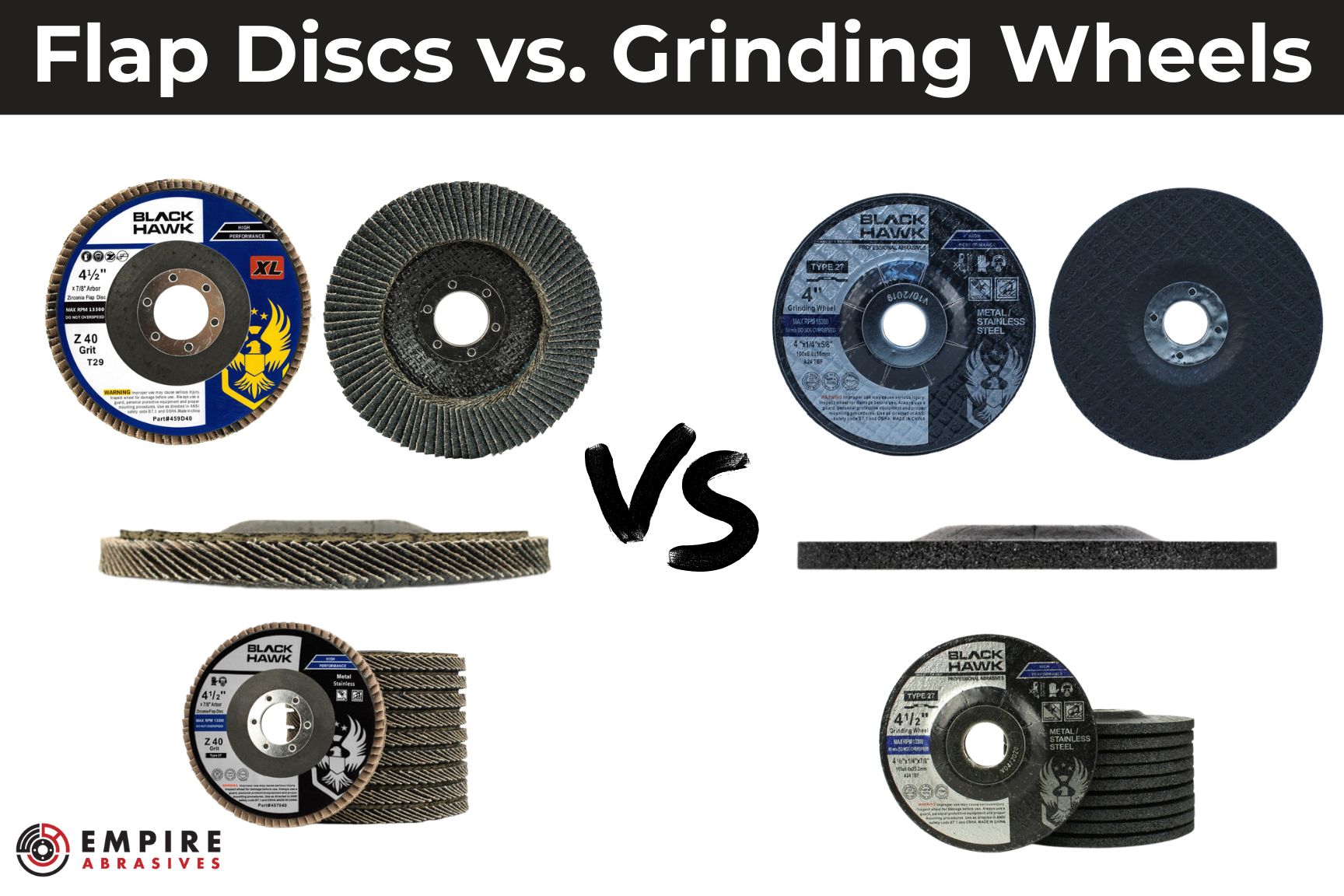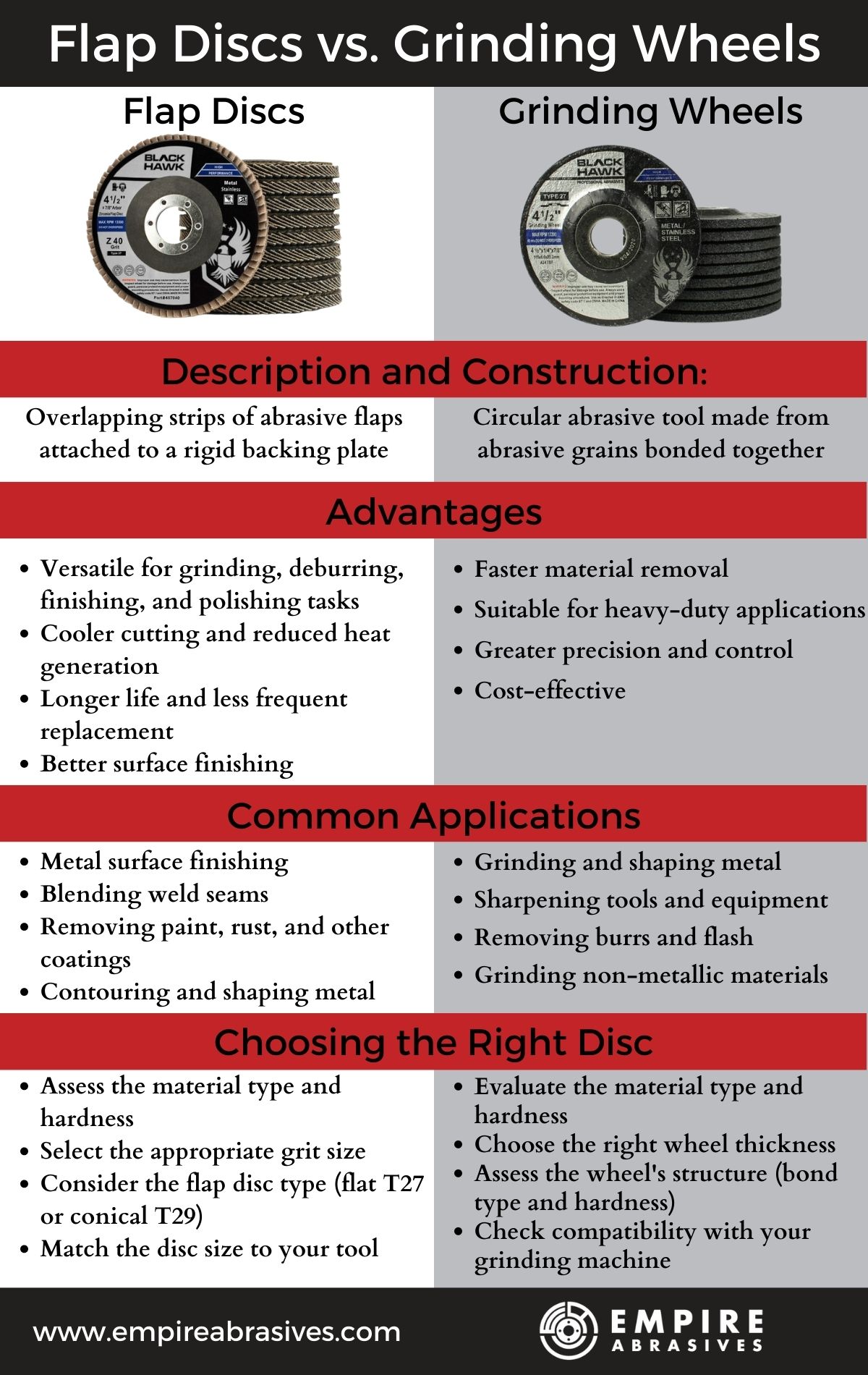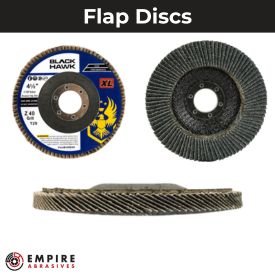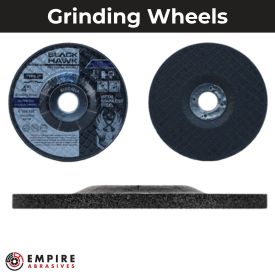
Flap discs and grinding wheels are two of the most used tools by metal fabricators, welders, mechanics, knife makers, and many other professions, hobbyists, and DIY enthusiasts. Both types of abrasive wheels are designed for grinding, cutting, and shaping materials, however, they differ in terms of construction, performance, and application.
Below, we go over the descriptions, advantages, and common applications of flap discs and grinding wheels, as well as tips for choosing the right abrasive tool, and guidelines for getting the most out of your abrasive tools. This article should help you decide which tool is right for your specific task. If you want to skip the article or get an answer right away, our abrasives experts are available during normal business hours to chat on site, email, or by phone.
Flap Discs
A. Description and Construction of Flap Discs
Flap discs are a cross between a grinding disc and a sanding disc with plenty of benefits. They are made by overlapping strips of coarse abrasive sandpaper (flaps) over one another, fanning out around the disc. These abrasive flaps are mounted to a rigid backing plate that keeps them in place and allows them the disc to attach to a different grinding tool, such as an angle grinder or die grinder. As the disc wears down during use, the flaps constantly expose fresh abrasive material, ensuring consistent performance.
There are some variations between flap discs, such as the type of abrasive grain (i.e., zirconia, aluminum oxide, or ceramic), specialty coated discs for grinding aluminum, the size of the disc, and even curved edges for grinding filet welds.
B. Advantages of using flap discs
- Versatility – Flap discs can be used for a wide variety of tasks, from grinding and deburring to finishing and polishing. They come in a variety of sizes, grits, and abrasive grains, which allows users to choose the right disc for their specific applications.
- Cooler cutting and reduced heat generation – The design of flap discs generates much less heat when compared to grinding discs. This is important when you don’t want to risk discoloring or warping a workpiece or destroying a soft metal like aluminum or brass.
- Longer life and less frequent replacement - The overlapping flaps on a flap disc continuously expose fresh abrasive material as they wear down, providing a longer lifespan and reducing the need for frequent disc changes.
- Better surface finishing – Compared to grinding wheels, flap discs are known to produce a smoother and more uniform finish. This helps eliminate the need for additional finishing steps and speeds up workflow.
C. Common applications of flap discs
There are many uses for a flap disc, but these are the most common applications:
- Metal surface finishing - Flap discs are used to create smooth, even surfaces on various metals, including steel, stainless steel, aluminum, and other alloys.
- Blending weld seams – Flap discs can be found in most welders’ toolboxes for their great ability to blend and smooth out weld seams.
- Removing paint, rust, and other coatings – When using a flap disc correctly, it can remove paint, rust, and other coatings without damaging the underlying material. This makes them an ideal abrasive product for surface preparation before painting or coating.
- Contouring and shaping metal – Unlike a rigid grinding wheel, a flap disc provides some flexibility that conforms to the shape of a workpiece. They can be used to contour and shape metal parts without causing gouges or excessive material removal.
D. Tips for choosing the right flap disc
- Assess your material – Consider the type and hardness of the material you plan to work on. General-use zirconia flap discs are great for most metals like steel, cast iron, titanium, nickel, and other ferrous metals. When working with softer metals, consider a flap disc for aluminum which is contaminant free, resists loading and chip-adhesion, and runs cooler than other flap discs.
- Select the right grit – Choose a grit size that corresponds to the desired level of material removal and finish. Lower grit numbers are more aggressive, while higher grit numbers produce a finer finish. - For more information on this - Sandpaper Grit Explained
- Consider the flap disc type – There are two different main types of flap discs, flat (T27) and conical (T29), both designed for specific applications. Flat T27 flap discs are ideal for flat surfaces, while conical T29 flap discs are better for working on curved or contoured surfaces. For more information on this - T27 vs T29 Flap Disc Differences
- Match the disc size to your tool – Choose a flap disc size that is compatible with your angle grinder or die grinder to ensure proper performance and safety. Do not ever try to fit a larger or smaller disc than your power tool is designed for. Just because you can get it to fit, doesn’t mean you should use it that way.
Grinding Wheels/Grinding Discs
A. Description and construction of grinding wheels
Grinding wheels (aka grinding discs) are circular abrasive tool used for grinding, cutting, and shaping various metals and other materials. Whereas flap discs are coated abrasives, grinding wheels are bonded abrasive tools. They are manufactured by combining abrasive grains with a bonding material, such as resin, rubber, or metal. Like flap discs, they also come in a range of sizes, grits, and abrasive materials that can be used for specific applications.
B. Advantages of using grinding wheels
- Faster material removal – Grinding wheels offer much more aggressive grinding and cutting power than flap discs and other coated abrasive sanding products. Tasks that require fast and/or deep stock removal would generally be best done with a grinding wheel.
- Suitable for heavy-duty applications - Grinding wheels can withstand high pressure and force, making them suitable for heavy-duty grinding applications and large-scale projects.
- Greater precision and control - The rigid structure allows for greater precision and control during grinding, ensuring accurate and consistent results to provide high-quality finishes.
- Cost-effective – Grinding wheels are generally more affordable than other abrasive tools, especially when considering their longevity and ability to remove large amounts of material quickly.
C. Common applications of grinding wheels
- Grinding metal – As the name suggests, they are designed for grinding metal. They are commonly used to shape, smooth, and refine the surface of various metal components, such as automotive parts, tools, and machinery.
- Sharpening tools and equipment – Grinding discs are often used to sharpen other tools and equipment, such as drill bits, lawnmower blades, knives, axes, hole saws, etc.
- Removing burrs and flash – Grinding wheels often used for removing unwanted material from metal, such as burrs and flash, providing a cleaner finish or a better surface during weld prep.
- Grinding non-metallic materials – Grinding wheels can also be used to grind non-metallic materials, such as glass, ceramics, and stone.
D. Tips for choosing the grinding wheel
- Evaluate the material – Just like with flap discs, consider the type and hardness of the material you will be working with to select the right abrasive grain for your grinding wheel. General-use aluminum oxide grinding discs work best on harder metals, while grinding discs for aluminum are the better choice for softer metals.
- Choose the right wheel thickness – Grinding wheels come in a variety of thicknesses. Thicker wheels are more durable and can handle heavy-duty tasks, while thinner wheels offer more precision and are better for delicate work or tight spaces.
- Assess the wheel's structure – Grinding wheels come in different bond types (such as resin, rubber, or metal) and varying degrees of hardness, which affect their performance and lifespan.
- Check compatibility – Ensure that the grinding wheel size and type are compatible with your grinding machine. Also check to make sure the maximum RPM of the disc is compatible with your machine.
Factors to Consider When Choosing Between Flap Discs and Grinding Wheels
A. Material type and hardness
Understanding the material you're working with is crucial in selecting the right abrasive tool.
- Flap discs - For softer materials
- Grinding wheels - Harder materials (like iron and stainless steel)
*This is an overview for general-use flap discs and grinding wheels. Flap discs can grind hard metals, but a grinding disc will remove more material faster. There are also specialty designed grinding discs, like the BHA Aluminum Grinding Disc, that can grind softer metals like aluminum, bronze, copper, and brass.
B. Desired finish and appearance
Get the finished product you want, the first time, by choosing the right abrasive product.
- Flap discs - For a smooth, polished finish
- Grinding wheels - For a more aggressive cut and/or projects that require high stock removal or more precision.
C. Workpiece shape
Differently shaped workpieces require different tools to get the right outcome.
- Flap discs - When you need a product that is more flexible and can conform better to the contours of your workpiece, especially one with curved or uneven surfaces.
- Grinding wheels - for flat surfaces or when you need to grind straight lines.
D. Time and cost considerations
Determining the importance of budgeting time vs money can be a deciding factor for many people.
- Flap discs - generally have a longer lifespan and require less frequent replacement, saving time and money.
- Grinding wheels - offer faster material removal, reducing the time spent on a project.
E. Safety and ease of use
Always follow proper safety precautions and manufacturers’ guidelines when using any abrasive tool.
- Flap discs - generally considered safer due to their cooler cutting nature, reducing the risk of heat-related damage to the workpiece or operator.
- Grinding wheels - may generate more sparks, dust, and heat, which can pose safety concerns. Improper use can also cause the disc to break or shatter while grinding.
V. Tips and Tricks for Getting the Most Out of Your Abrasive Tools
A. Proper maintenance and storage:
Just like all other abrasives, flap discs and grinding wheels clean and store them in a dry, cool place to prevent damage and prolong their lifespan.
For more information on storing flap discs - Coated Abrasives 101: How to Store and Maintain Them Properly
B. Best practices for using flap discs and grinding wheels:
Always wear appropriate safety gear, maintain a consistent pressure and speed while working, and avoid overloading or overheating your abrasive tools. Never use an abrasive disc that appears to be damaged.
C. Maximizing the lifespan and performance of your abrasive tools:
Regularly inspect your tools for wear and replace them as needed and follow the manufacturer's recommendations for maintenance and use.
Conclusion
In conclusion, flap discs and grinding wheels are both versatile metalworking tools with many similar applications, but with differences in how they should be used. Flap discs are flexible and versatile, providing a smooth finish and conforming to contours, making them ideal for blending welds, removing paint, and finishing metal surfaces. On the other hand, grinding wheels offer faster material removal, increased precision, and are better suited for heavy-duty applications, such as grinding metal, sharpening tools, and removing burrs and flash.
Choosing the right abrasive tool for your projects is the first step in achieving the best results possible. This will help not only with the outcome of the project, but with maintaining efficiency, safety, and cost-effectiveness. Factors such as material type, desired finish, workpiece shape, time and cost considerations, and safety and ease of use should be considered when deciding between flap discs and grinding wheels.
As with any tool or technique, it is a good idea to explore both options and experiment to find the best solution for your specific needs. Don't hesitate to try out different abrasive tools and techniques to discover which one works best for you and your projects. By selecting the right abrasive tool and mastering its use, you can improve your skills and achieve exceptional results in your work.
Ready to take your metalworking projects to the next level? Explore our wide selection of high-quality flap discs and grinding wheels at Empire Abrasives and start achieving exceptional results today! If you have any questions, our abrasives experts are available to chat on EmpireAbrasives.com website, email, or just a phone call away. Don't forget to check out our blog for more tips, tricks, and expert advice on all things abrasives!



